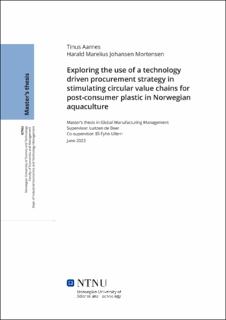| dc.contributor.advisor | de Boer, Luitzen | |
| dc.contributor.advisor | Ullern, Eli Fyhn | |
| dc.contributor.author | Aarnes, Tinus | |
| dc.contributor.author | Mortensen, Harald Marelius Johansen | |
| dc.date.accessioned | 2024-03-13T18:19:40Z | |
| dc.date.available | 2024-03-13T18:19:40Z | |
| dc.date.issued | 2023 | |
| dc.identifier | no.ntnu:inspera:147161417:154024447 | |
| dc.identifier.uri | https://hdl.handle.net/11250/3122236 | |
| dc.description.abstract | Sirkulærøkonomien har i nyere tid vært sentralt i å redusere miljøpåvirkningen av industrier. Dette oppnås ved å lukke material- og energikretsløpet i samsvar med prinsippene gjenvinning, resirkulering og verdibevaring. Imidlertid krever den omfattende innføringen av sirkulærøkonomi en stimulans. I denne oppgaven vil vi utforske hvordan bruken av en teknologisk støttet innkjøpsstrategi kan stimulere leverandører i oppdrettsindustrien til å levere mer sirkulære produkter og materialer. Denne oppgaven er skrevet med inspirasjon fra prosjektet POCOplast. Ved å kvalitativt undersøke to aktører som er inkludert i dette prosjektet, Grieg Seafood og Flokk, ble potensialet til innkjøpsssfunksjonen for å stimulere sirkulærøkonomien utforsket, samt hvordan teknologi kan forsterke disse effektene. Grieg Seafood er en stor forbruker av plast og plast er et viktig materiale for deres oppdrettsvirksomhet. Grieg Seafood har som mål å stimulere sirkulærøkonomien ved å øke bruken av resirkulert plast, samtidig som de identifiserer muligheter for at deres plastavfall kan brukes i andre bransjer. Flokk er allerede en etablert forbruker av resirkulert plast i møbelindustrien og er interessert i å øke tilgangen på post-consumer plast. Et rammeverk ble brukt for å knytte litteraturen om sirkulært innkjøp og teknologi til disse kvalitative funnene for å analysere resultatene. Innkjøps potensiale for å stimulere sirkulærøkonomien ligger i utviklingen av kriterier og spesifikasjoner som er i tråd med organisasjonens overordnede strategi for sirkulærøkonomi. Dette inkluderer både graden av sirkularitet til produktene som kjøpes inn, og forretningsmodellene som brukes. Ved implementering av sirkulære forretningsmodeller er det viktig å opprettholde prinsippene for gjenbruk og bruk av sirkulære materialer for å oppnå en positiv miljøpåvirkning. Med økt sirkularitet og modenhet av konseptet kan kostnadseffektiviteten til sirkulære produkter øke, samtidig som bekymringer knyttet til kvalitet og levetid kan reduseres. Teknologi, både grunnleggende teknologi som ulike IKT-løsninger og mer avanserte teknologier som sporingssystemer, kan gi informasjon og innsikt slik at mer sirkulære spesifikasjoner kan utarbeides. Denne teknologikategorien kan også tilby systemer og grensesnitt for innkjøpere og leverandører slik at informasjon kan deles, og at det kan samhandles mot felles mål. Teknologi for gjennomsiktighet og åpenhet i verdikjeden kan gi tilstrekkelig informasjon om opphavet av produkter og materialer, slik at en overgang fra en enkelt-leverandør strategi til en fler-leverandør strategi kan innføres. Med disse elementene er det da beskrevet hvordan en teknologisk støttet innkjøpsstrategi kan stimulere sirkulærøkonomien i oppdrettsnæringen. | |
| dc.description.abstract | The circular economy (CE) has in recent years been at the forefront in reducing the environmental impact
of various industries. This is achieved by closing the loop according to the principles of recovery, recycling,
and value retention. However, the widespread introduction into a circular economy requires a stimulus.
In this thesis, we will explore how the use of a technologically enabled procurement strategy can stimulate
suppliers in the aquaculture industry to provide more circular products and materials. This thesis was written
with inspiration from the POCOplast project. By qualitatively examining two actors included in this project,
Grieg Seafood and Flokk, the potential of the procurement function to stimulate the circular economy was
explored, as well as how technology can further enhance these effects. Grieg Seafood is a major plastics
consumer and plastic is a key material for its aquaculture operations. Grieg Seafood aims to stimulate the
circular economy by increasing their sourcing of recycled plastics, while also identifying opportunities for
their plastic waste to be used in other industries. Flokk is already an established consumer of recycled plastics
in the furniture industry and is interested in increasing the supply of post-consumer plastic. A framework was
used to link the literature on circular procurement and technology to these qualitative findings to analyse the
findings. Procurement’s potential in stimulating CE lies in the creation of criteria and specifications that are
in line with the organisation’s overall CE strategy. This includes both the level of circularity of the products
purchased and the business models used. While implementing circular business models it is important to
maintain the CE principles of re-use, as well as using circular materials to see a positive environmental
impact. With increased circularity, and maturity of the concept, the cost-effectiveness of circular products
could increase, while alleviating concerns related to quality and lifetime. Technology, both basic technology
like various ICT solutions, as well as more advanced technologies such as tracing solutions, can provide
information and insight so that more circular specifications can be devised. This category of technology
can also provide systems and interfaces for procurers and suppliers to share information and collaborate
toward shared objectives. Technology for supply chain transparency can provide sufficient information
regarding the provenance of materials, so that the transition from a single to a multi-sourcing strategy might
be implemented. With these elements, it is thus described how a technologically driven procurement strategy
can stimulate the circular economy in the aquaculture industry. | |
| dc.language | eng | |
| dc.publisher | NTNU | |
| dc.title | Exploring the use of a technology driven procurement strategy in stimulating circular value chains for post-consumer plastic in Norwegian aquaculture | |
| dc.type | Master thesis | |
